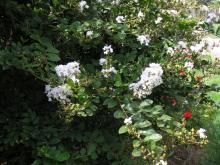
High Plains Gardening
The gardening website of the Texas High Plains Region

Grown in the South for decades, most people think of crape myrtle as a native American plant; it is however native to China and Japan. Small tree or large shrub that is cold hardy to Zone 7. I’ve grown the same crape myrtles for over 20 years, but they’re planted close (too close!) to my bricked house on both the northeast and northwest corners. They’ve been stem hardy, not just root hardy, and have grown up to about 10-12’. In most cases, crape myrtle will not grow into tree form in the Panhandle, but there are mature, tree size crape myrtles in Amarillo. The smooth bark is pink and gray mottled and is very attractive in tree form. As a shrub, the bark is not easily noticed. The leaves are small and glossy green that turn a pleasing orange red in autumn. Small crinkled flowers in clusters, or panicles to 4 – 8”, which turn into brown capsules in autumn. An all around good choice for alkaline soil that will be low water-use once established (3 years) in a somewhat sheltered location. Do not lament in the springtime; crape myrtle will be among the last plants to leaf out, usually not until June in our climate. Crape myrtles can be killed by a late freeze in warmer climates -- this is unlikely to happen here. In unusual and extremely cold winters or with early sudden freezes, crape myrtles could succomb and die. Local nurseries will usually carry varieties that will be reliably cold hardy in most years.
Sun, sun part shade. Shrub bed or border. As an accent plant. Sometimes a small tree.
Top dress with an inch of compost spring and fall.